Joey Holder
Abyssal Seeker
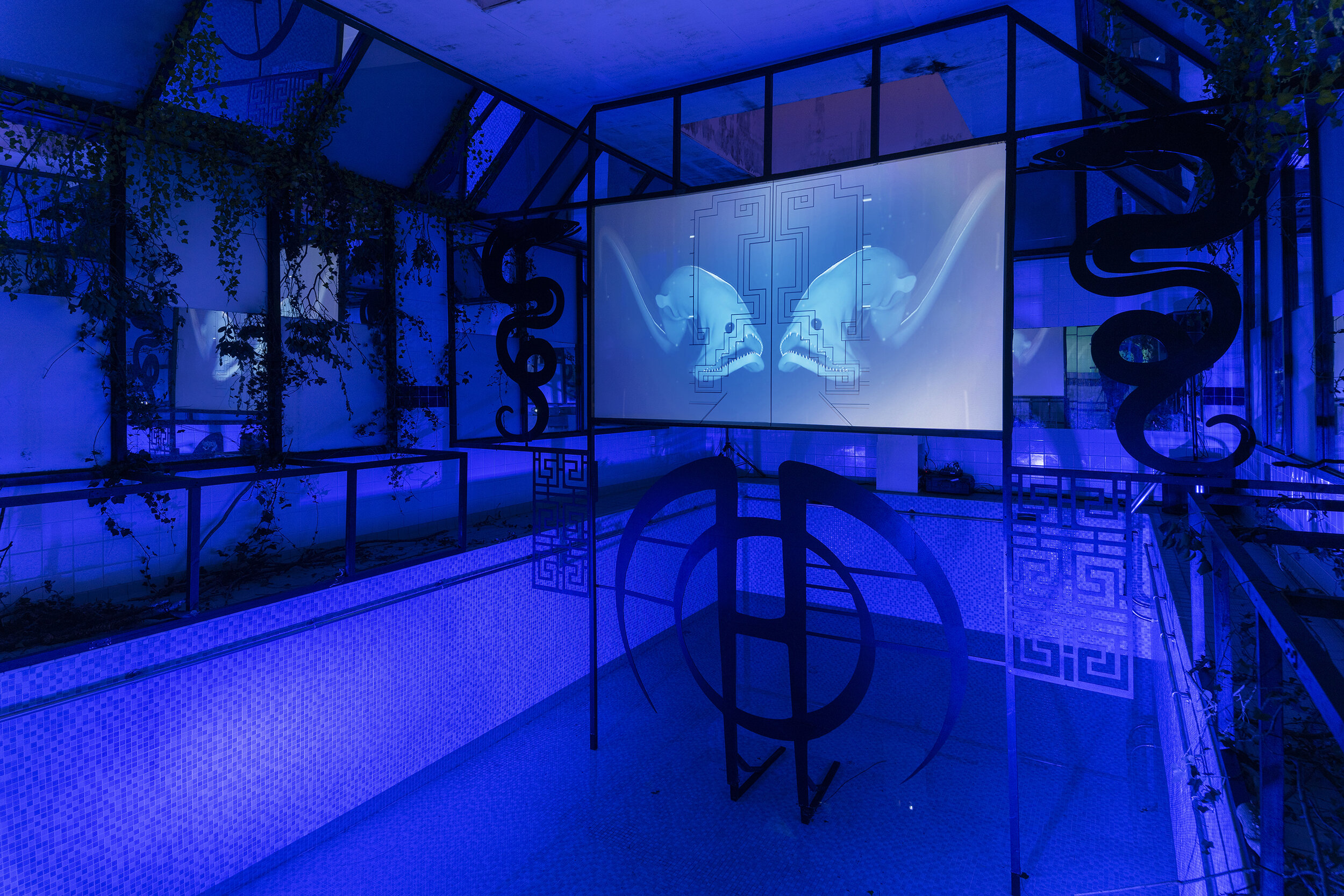
Joey Holder, installation view: Semelparous, 2020. Courtesy of the artist. Photo: Damian Griffiths.
I’ve been feeling really cosmological lately. I’ve been thinking about the universe and how big it is, how remote from anyone else we are, how weird it can be. Space is a weird, psychedelic environment. I’m interested in the idea of cosmological consciousness and how consciousness emerges from matter. How do we define consciousness? I don’t think we actually have an idea of consciousness beyond our own subjective experience of having consciousness. We can’t define what it is, but we know it when we see it and feel it.
Think about the layers of the ocean. Can you feel the fluorescent warmth of the Sunlight Zone as it slips off the continental shelf? Think about the changing quality of the light as it cuts through 1,000 meters of salt water and beams become hazy and muted as they dissipate into the Twilight and Midnight Zones, 4,000 meters down, as deep as Mount Rainier is tall. Think about the technical terms for these places defined by their lack of light – Mesopelagic and Bathypelagic. Let those words slosh around in your salt-puckered mouth as you consider the anatomy of the angler fish, snipe eel, and vampire squid – thin as ribbons, bulbous and spiny as Venus flytraps, webbed like the Creature from the Black Lagoon. Their pallid, slimy skins are barely illuminated by a thin rod of bioluminescence – a lightning bolt from inside of the body, bleeding out.
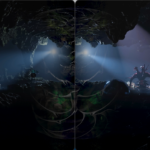
Joey Holder, Abyssal Seeker [Demersal Zone], 2021. 2 channel HD video with sound and projection screen. 7 mins 41 sec. Courtesy of the artist and Seventeen Gallery, London.
Now think deeper, like 6,000 meters more, to the darkest part of the ocean. Far deeper than the tallest points on Earth, think about a body of water so dark that its inhabitants aren’t even trying to generate light, or waste energy with their coloring. Think about these transparent organisms that have ditched their own organs to avoid being crushed by the water pressure – or, like the Cusk-eel, creatures who body snatch invertebrate hosts, tripping from one corporal annihilation to the next. There is no light, no oxygen, but plenty of nitrogen and silica in layers of fossilized organic material pulled down over millennia, a kind of reverse and undead exoskeletal memoriam of life on Earth. We know nothing of this world but it encompasses 80% of the ocean and over half the Earth’s surface.
Joey Holder’s latest project Abyssal Seeker (2021) is a plunge into this unknown environment that’s rich in speculative-fact. It’s set in an unspecified future or alter-reality where humans have descended into the deepest layer of the sea to merge with these wicked primordial Gods.
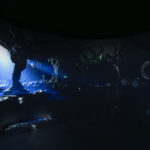
Joey Holder, Abyssal Seeker [Demersal Zone], 2021. 2 channel HD video with sound and projection screen. 7 mins 41 sec. Courtesy of the artist and Seventeen Gallery, London.
We seek kinship and collusion with the strange and estranged creatures, morphing our bodies and entangling ecologies to escape today’s all-encompassing technological surveillance network. We shrink and twist and grow gills and snake spines and float in a protogenic soup of black opacity, a space far darker and more cosmic than the pragmatic beeline trail of any fiberoptic cable. Holder describes the work as an “escape strategy against tracking and the totalization of life in a sci-fi like way” but also not; it’s a refusal of the zeros and ones of Big Tech’s roaming tabs and sober essentializing complex, a descent into the muck of uncategorizable life, a Weirded cosmic clock.
The act of creating magic is visionary, and a split second of a realisation that you have that vision. I mean, it’s not like we’re sitting here conjuring up dragons.
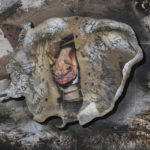
Joey Holder, Centurio senex, 2021. Pigment print on cotton paper mounted to aluminium. 40.5 x 53 cm. Courtesy of the artist and Seventeen Gallery, London.
I spent the first half of the 20th century learning magic, mostly in a traditional way, where I would go to a master, apprentice myself to him or her, learn an act, then get on stage and try to do that act. That was my kind of learning process, and the first half of the 20th century was very much based on that. Towards the end of the century, it was clear to me that I just wanted to create original work. So, I began to work in a more hybrid way. It’s very difficult to explain to someone how you do anything. I remember there was a time that I was thinking about how I would learn to do a certain trick, a sleight of hand trick, a trick of the light. I would say, okay, I’m going to focus my energy and my concentration and my intention on this thing, and then go to the library and take out all of the material that I couldn’t master just through thinking about it. That’s how I learned magic.
Demersal Zone, a curving semicircular video projection, lets these speculative critters loose in a fluorescent-streaked aquatic landscape. This rendered sea floor is chimeric; it morphs from an allegorical cave stacked high with stalactites into a hardened steel container reminiscent of the industrialized cabinets of eels at wet markets. A delicately shrieking and water-logged soundtrack by 33EMYBW loosely stitches these scenes together, with plenty of blackouts in between. Towards the end of the video, a spectacular spherical beast with tendrils aflutter teleports into the scene – opaque yet transparent, it could be planetary or microcosmic in scale – nobody’s around to take the measurements, and that doesn’t really matter.
After the departure of the organic Orb, darkness dominates. It’s split open only by the occasional flash of blue light (the only shade on the electromagnetic spectrum that can penetrate beyond the Twilight Zone) – illuminating a wayward tentacle here, a flicker of an eel there. But the blackout abyss hallucinates fantastical hybrids; Donna Haraway’s idea of the Chthulucene – as a pivot away from the visible and taxonomized life-forms of the Anthropocene, as an entangled burrowing beneath the epidermis of our knowledge of the planet and its interconnected ecologies, a tentacular connection of all life-beings – feels somewhere close in the dark. Through Holder’s watery storytelling we arrive at our own visuals for this interspecies kin and wild new systems of living together. In this ambitious and ambiguous gesture, Demersal Zone extends a webbed claw out to earlier works, including Semelparous and Adcredo.
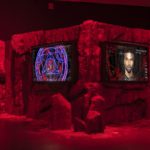
Joey Holder, installation view: Adcredo - The Deep Belief Network, 2018. Courtesy the artist. Photo: Damian Griffiths.
I’m working on a piece right now called Abyssal Seeker, and it’s sort of this physical meditation on relationships and death and friendship and love. The piece is sitting at the bottom of the sea, and it’s made out of some kind of porous material. It’s a very concrete piece. It’s something I’m working on developing because I didn’t want to make a really big all-encompassing, fake whale skeleton-type piece out of plastic. I wanted to do something that was more grounded.
Emerging from the deepest, darkest layer of Abyssal Seeker, we encounter a landed body double. Littoral Zone is named after the fabled shore, a space where water meets land, the site where life first crawled out of the water 430 million years ago, triggering what biologists refer to as the Cambrian Explosion of Life. Of course, this plot stems first from the gathering of molecular lifeforms slushed about in the ocean in a primordial soup, a woozy catalytic synthesis ricocheting from the energy of interstellar meteoric collisions. But this is an old story. So boring and young and frictionless. Some scientists are re-evaluating this practically sanctified claim inscribed in evolutionary biology textbooks world-over. Turns out there was an extinct group of organisms called Ediacara, which last lived on Earth some hundred million years before the rise of amphibious plants. Turns out they’re the spitting image of the tubular phantom life-forms of clinging onto . Did they take one look at a future world above water and turn back?
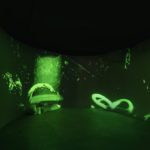
Joey Holder, Abyssal Seeker [Demersal Zone], 2021. 2 channel HD video with sound and projection screen. 7 mins 41 sec. Courtesy of the artist and Seventeen Gallery, London.
The hardened topography of Littoral Zone is comforting, if hallucinogenic. Sigils and complex diagrams of social order collapse onto the roughly-hewn rock print mounted on aluminum. Cephalopods and chiropterans emerge from layered cotton-printed caves enshrined by molecular diagrams and other hazy info-collages, generating a symbolic vacuum effect, a concentration of energy and matter onto hard ground. You are here.
I think that there was a moment in the history of magic when the relationship between the magician and the audience was very direct. You have a close relationship with the audience, you recognize their presence, you recognize their desire to be mystified by you. I think the sense of that performance where you’re very much in the ritual space with the audience, rather than above them, is very important. In Covid times, creating this space, you suddenly have the power – you can invite whoever you want to your world and they can visit it. Even if you’re not in the same room, you can still meet. So it’s a way of overcoming geographical barriers to interaction. You feel that you’re in a ritual space with people.
It’s in the layers. The ocean, time, bodies, the internet. The powers of condensation and expansion. The power of porosity. Holder addresses the cosmology of networked belief systems; the ways the Dark Web functions much like the Abyssal Zone, a conjuring of who-knows-what beyond the blackout, beneath the dermal layer that entertains and bewilders with its innocent interface of day-to-day browsing or a scraped knee.
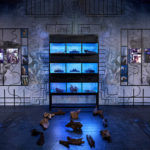
Joey Holder, Khthon, 2020. Wallpaper, UV prints on light box fabric, light boxes, glass, steel, silicone, cacti, earth, driftwood. Courtesy of the artist and Seventeen Gallery, London.
We talk about the ways the internet expanded our social circuits in the pandemic, which overlaid or maybe propelled Holder to move away from accelerating apocalyptic doomsday scenarios through artificial companies like Adcredo and into a generative unknown, both in her latest project and the two alternative programs she helps organize, Chaos Magic Space and SPUR. We talked about the hidden worlds the pandemic revealed – maybe the porous plane of our skins dilated somehow or just our understanding of it, when we became unwitting hosts to a new virus – a microcosmic life-form that joined the 97% of bacteria living on our bodies that we still don’t understand. So maybe traveling to this dark abyssal space at the bottom of the ocean, or the deepest crevices of the web, isn’t so essential to propel us into a space of an entangled unknown, a more-than-human world. It’s possible the most strange and alien and mythical beasts that we can dream up in the shadows of these spaces could never actually surpass what is already here in the world, with us, on our feeds, in our skin. We just need to get our feet wet in the primordial soup.
I mean, it’s weird how the internet has been this incredibly liberating resource for all kinds of people; like-minded people who have ideas and opinions that for a long time have been suppressed. It’s allowed them to build a community, but it’s also allowed minority groups like the alt-right to organize as well… I’m sort of becoming more sensitive about my online presence now. I am concerned about the way that the internet is shaped, and the way these potential futures are emerging. My wife is a big activist, she’s been involved in pro-democracy movements around the world, and I also have been at some point, but we also have never been part of a community that is so against this idea of democracy. I’m interested in being involved in this movement, so I’m just going to dip my toes in the water and see how it goes.
Joey Holder, Abyssal Seeker, 2021.








